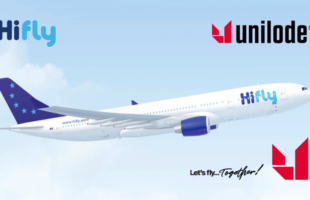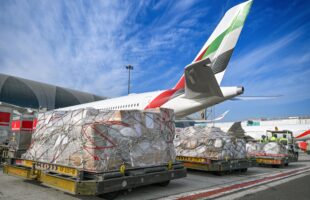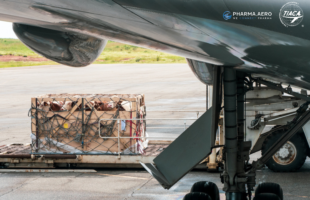

Imagine being able to switch to cargo at any time, or better yet, banking on cargo operations with a passenger fleet. For most airlines it would be impossible to ignore this idea given how the industry has been impacted by the coronavirus pandemic. From the steep drop in travel demand to moving aircraft to deserts, airlines have had a lot to think about during the past year, including where to get much needed revenue.
Whilst the chaos was unfolding, a greater population of people were living in front of their screens, tucked in from the outside world and transacting through e-commerce. From designer clothes to the latest portable oven or smartphone, more people were buying online like never before.
The ‘e-commerce requirement’
This ‘boom’ was creating a whole different demand for logistics and deliveries, with volumes of e-commerce shipments too large to ignore, according to SmartKargo chief executive Milind Tavshikar.
Milind believes e-commerce offers a great opportunity for airlines who are struggling to find any revenue in the pandemic, with everybody forced to order things from their homes. “E-commerce websites need a shipping channel that they can use to transport the goods, and airlines have been able to step up and fill that gap and provide the commerce sites with that option to move goods from the warehouse to the door of your consignee,” he said.
But even before the pandemic, Milind has observed a new type of ‘e-commerce requirement’ developing in the air cargo market: one that entailed delivering at the shortest possible time at the cheapest possible cost. With this in mind, if you are a consumer buying on Amazon and getting shipment from Prime, you would expect the same service. Consumers expect the speed of delivery to match the price they pay, whilst shippers who are willing to pay the extra dollar to absorb the costs.
From carrier to integrator
This e-commerce requirement goes down to one-piece shipments of 1 to 5 kilograms that most integrators like DHL, FedEx, UPS and of course, Amazon are familiar with. SmartKargo has extended its solution to allow airlines to act in a similar manner. It enables an airline to become an integrator, Milind claims.
“Those [piece-level] shipments were usually carried by integrators wherever they existed or they were carried by the local post offices if they had a service. What we have done is we have now extended our solution. The operating system now not only caters to the freight forwarder marketplace, but also allows an airline to participate in e-commerce shipping,” he said.
The CEO added, “That’s the most lucrative business because the yields are very high. The package size is very manageable, because the narrow body fleets or even ATR planes, or regional jets, all of them can carry commerce parcels, because everything, between one to five, or maybe 10 kilos, small-size parcels. It requires piece-level identification and tracking, and we are the only solution who can do that, you know, because every piece is like a passenger.”
Ahead of the cargo game
With higher yields for e-commerce shipments, it would seem that carrying parcels for e-commerce companies on the bellyhold or modified main decks would be the ideal solution for cash-strapped airlines. So, how come not everyone’s doing it?
Milind says most solutions were never built for the end-to-end scenario and only catered to the freight forwarding marketplace, and the bulk cargo situation. Most of them were built as offline record-keeping environments and cargo teams had to use multiple products for booking operations and accounting. Meanwhile, vendors came up with modules of technology that cater to only one piece, more like a sophisticated Excel. “Although it was called a cargo product, it was a very sophisticated Excel,” he added.
What SmartKargo did was changed that perspective. “In the beginning, we said, it’s not just a sophisticated Excel and record keeping mechanism. It is a business operating system. And it is extended for an end-to-end scenario. That’s how we envision this 10 years ago. We were a little ahead of our time then,” he continued.
Playing catch-up
Milind narrates that 10 years ago,airlines were aloof to the idea of an end-to-end logistics service. “In 2010, one or two airlines kind of turned in and said, ‘Okay, it’s interesting.’ But in most cases, they were very skeptical about it, perhaps content with getting the revenue from cargo but not very ambitious about growing the cargo business, especially logistics components of road integration, etc.
He added that there was also some sort of reluctance given the idea that this would step on the freight forwarders—the cargo division’s main important customers—because of market confusion.
But in the last three years, things have started becoming different because the volume of e-commerce cargo is humongous, to the point you cannot ignore it, he expressed. At the same time, people have realised that these are two different markets.
“Just because you’re doing e-commerce cargo does not mean that you’re stepping on your own customer, that is not the case. These are two different independent markets. To understand and realize that took some time for the airline industry. At the same time, the need to have additional revenue now is driving the demand, and that’s the reason why they have now started doing this.”
Now most airlines have to play catch-up to this business model, he says. “It is a very hard thing to get into play catch up. Because these are complex systems, and to re-engineer a product like that takes multiple years of catch up.”
The case for an e-commerce airline
One airline that managed to make the transition was Azul Brazilian Airline, Brazil’s third-largest carrier, which implemented a SmartKargo solution for domestic e-commerce in January last year. The airline is connected to over 300 e-commerce websites.
“When a customer or a buyer clicks add to cart, Azul starts the electronic operation with the shipment. It is integrated directly to the browser of an e-commerce buyer, where a browser connects to the SmartKargo system operated by Azul and creates an air waybill,” he said. This means the airline knows where the air waybill needs to be picked up, because the SKU is in one of the fulfillment centers, and where it has to be shipped and is able to block capacity and provide pricing and ensure that a service-level agreement is made with that one shipment.
“It is the SLA at a shipment level, pricing at a shipment level, capacity at the shipment level and all of this is dynamic and that’s what we call an e-commerce airline. It is not a blanket contract, which allows shippers to use a contract rate; this is dynamically available and this is all [in] real time.”
Finding untapped markets
With the successful use case of the Brazilian airline, SmartKargo is looking to duplicate this in other markets and is focused on creating a global cargo marketplace for airlines. A recent injection from investment firm M33 Growth, Milind says, allows the company to extend its solution to geographies like Philippines, India, or even China and Africa—growing e-commerce markets where DHL, or FedEx or UPS have very limited capacity. Aside from Azul, the company said its e-commerce operating system is already live with Air Canada and at some point will come to Asia Pacific.
“The investment allows us to expand rapidly and provide airlines that operating system that they can use to conduct e-commerce shipping as one of the business lines,” Milind continued. “We are the only solution that allows airlines to behave and perform like a logistics player, where an airline can have a very strong value proposition around speed, quality and cost.”
The company says it has put investments in upgrading its product, working with the likes of MIT and Harvard Business School to provide innovation aspects that are ahead of time and which the industry will need in the future. “Now the use case has become very appealing because of volumes. That’s kind of how I think we envision ahead of time on what the industry is going to need a few years from now,” Milind added.
Giving cargo a seat
Moving forward, the company is looking to integrate industry play and change the revenue model not just for airlines, but for the entire industry. Milind predicts the share of cargo revenue to grow five or 10 times in the next four or five years, growing from $7-10 billion industry to $50 billion.
“It’s a lot of money that is available, and the demand is only growing by the year. There is no easy way to generate capacity, and airlines have that capacity. Only 20 percent of the payload space is used for baggage in most cases. If you apply the 80-20 rule for flights, 80 percent of flights have no less than 20 percent of the space used by baggage. That’s a lot of unutilized space that can be monetized by these airlines, and it is a perfect fit for e-commerce shipments.”
One could say that SmartKargo is empowering a new breed of airlines with e-commerce capabilities that are now being sought after by early skeptics, who now have to play catch-up. But for those who managed to work with the company before or have only used the air-to-air solution and not the full chain service, Milind says it is very easy for them to extend the same thing to the e-commerce world: “the product was designed to do that.”
“We treat each box as a passenger seat. It will never happen that an e-commerce box went to an airplane and it does not have a seat. In the e-commerce world, this cannot happen. It has to be committed for a service level, it has to be committed for a price, it has to be committed at the same point that the buyer has clicked buy and ship. Unless an airline has that capability, it cannot be called an e-commerce airline. You are still a cargo airline where a freight forwarder could bring cargo and nobody’s sure whether the cargo will fly.”
The SmartKargo chief notes that the future growth pattern is to make one shipment look like one passenger: everything is real time. “The expectation is to create a digital environment where it is seamless, where it is end to end, where there is no drop in the service level. Cargo is as important as a passenger and it is possible today because of the technology that we have put in place. It is a new marketplace and that’s where we are transforming the industry. We are growing the revenue for the whole cargo industry as such, especially the air cargo industry, and not just providing a tech solution.”









